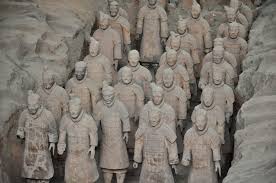
What Do the Terracotta Army Represent?
The Terracotta Army is one of the most iconic archaeological discoveries of the 20th century. These life-sized clay soldiers, chariots, and horses, buried near the tomb of Qin Shi Huang, the first emperor of China, continue to captivate and intrigue people around the world. But what do these figures represent, and what do they tell us about ancient Chinese beliefs and practices?
A Category of Ancient Funerary Sculptures
The Terracotta Army belongs to a broader category of ancient Chinese funerary sculptures. These sculptures, often made of clay or wood, were placed in tombs to serve a variety of purposes. Some were believed to provide comfort and companionship to the deceased in the afterlife, while others were intended to protect the tomb from evil spirits. In some cases, these figures represented the wealth, status, and achievements of the deceased in their earthly life.
The Ancient Practice of Human Sacrifice
To understand the significance of the Terracotta Army, it's essential to consider the ancient practice of human sacrifice. In many ancient cultures, including China, it was believed that rulers and powerful individuals needed retainers and servants in the afterlife, just as they did in life. This belief often led to the practice of human sacrifice, where servants, concubines, and even family members were killed and buried alongside the deceased.
During the Shang Dynasty (c. 1600-1046 BCE), human sacrifice was a common practice in royal burials. Slaves, considered the property of their masters, were seen as extensions of the ruler's power and possessions. Consequently, upon the ruler's death, these slaves were sacrificed and buried alongside their master to serve him in the afterlife.
The Evolution from Human Sacrifice to Symbolic Substitutes
Over time, the practice of human sacrifice gradually declined, replaced by more symbolic substitutes. Miniature figurines made of clay or wood, representing soldiers, servants, and entertainers, became common features in elite tombs during the Zhou dynasty (c. 1046-256 BCE). These figures served a similar purpose to human sacrifices, providing the deceased with a retinue in the afterlife, but without the brutality of taking actual lives.
The Terracotta Army: A Monumental Expression of Symbolic Substitution
The Terracotta Army represents the culmination of this transition from human sacrifice to symbolic substitution. Qin Shi Huang, eager to secure his power and legacy in the afterlife, commissioned the creation of this vast army of clay soldiers. These figures, each unique in their facial features and attire, served as a powerful symbol of his imperial might and a testament to the vast resources at his command.
The Terracotta Army, therefore, represents more than just a collection of impressive sculptures. It reflects ancient Chinese beliefs about death and the afterlife, the evolution of funerary practices, and the immense power wielded by the rulers of ancient China.
Q&A
Q: Why were the Terracotta Warriors made of terracotta?
A: Terracotta, a type of earthenware clay, was readily available in the region and relatively inexpensive to work with. It also proved to be a durable material, capable of preserving the figures for centuries.
Q: What is the significance of the different ranks and weapons depicted in the Terracotta Army?
A: The variety of ranks and weapons reflect the strict military hierarchy and sophisticated weaponry of the Qin army. This attention to detail highlights the emperor's desire to maintain his military power even in death.
Q: What happened to the Terracotta Army after its burial?
A: Over the centuries, the underground chambers housing the Terracotta Army collapsed, crushing some figures and exposing others to the elements. However, this collapse also helped preserve the army by shielding it from looters and the ravages of time. The accidental rediscovery of the Terracotta Army in 1974 by farmers digging a well sparked one of the most significant archaeological excavations of the 20th century.